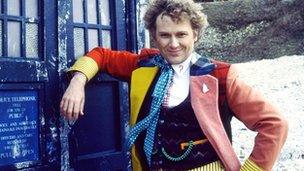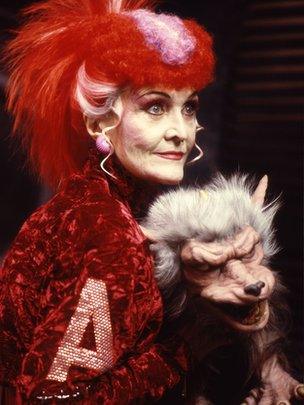Was Doctor Who rubbish in the 1980s?
- Published
- comments
Was Doctor Who rubbish in the 1980s?
Doctor Who is 50 this year and has plenty to celebrate. But just like chart-topping bands with albums they wish they had never released, the veteran sci-fi TV show has had its share of turkeys. Why is the 1980s the decade so many fans love to hate?
It started well. John Nathan-Turner, the new producer, revamped the opening titles. He cast a new doctor, Peter Davison, and cut the jokey tone.
Other changes were out of his hands.
Sylvester McCoy: 'Even though I was on it, my children would rather have watched The A-Team'
Doctor Who was evicted from its Saturday time slot, the itinerant Time Lord roaming the TV schedule in an increasingly desperate search for an audience.
At the same time the big budget sci-fi cinema seen in films like The Empire Strikes Back was being emulated by US TV imports such as Battlestar Galactica.
But what didn't change was the way Doctor Who was made. Complex special effects had to be conjured up in evening studio recordings, a way of producing TV more suited to courtroom drama or soaps.
Sylvester McCoy, lead actor from 1987 until the programme was cancelled in 1989, laments that there was never enough time to do the special effects well - a Time Lord unable to turn back the clock.
The case for the prosecution? Colin Baker, McCoy's predecessor forced to wear possibly the most distracting costume ever devised for a leading man, the casting of celebrities (including Beryl Reid, Richard Briers and Ken Dodd) as well as minor pop stars in guest roles, and forgettable baddies, like a green sea monster called The Myrka, external.
Doctor Who script writer Andrew Cartmel rates the programme's 1980s special effects
The actors inside the costume had managed to give some character to the pantomime horse in the children's programme Rentaghost, external, but even they couldn't save The Myrka from plumbing the inky depths of TV special effects.
The demise of the Myrka was played on Room 101 to illustrate Michael Grade's antipathy to 1980s Doctor Who. As Controller of BBC One, he suspended the show for 18 months in 1985.
"I thought it was rubbish. I thought it was pathetic," Grade told the programme, "cardboard things probably clonking across the floor, trying to scare kids. You just sit and laugh at it."
Hang on, though. 1980s Doctor Who doesn't have a monopoly on imaginative ideas that don't work.

Colin Baker's Doctor Who costume was a garish mix of colours
The Dalek Invasion of Earth, external (1964) was apparently carried out by wobbling flying saucers which wouldn't have been out of place in the classic cinema flop Plan 9 From Outer Space, external.
The Talons of Weng Chiang, external (1977), an evocative slice of life on the seedy side of Victorian London, is marred by a laughable giant rat costume.
Years later, the costume designer, James Acheson, given more money and time on feature films like Dangerous Liaisons, deservedly won three Oscars.
So why do stories from the 1980s routinely get such a hard time?
Production techniques and effects budgets could not match feature films. Even video games made Doctor Who look dated. BBC bosses of the time now admit they did not know what to do with the programme, and rather hoped it would go away.
John Nathan-Turner tried to keep Doctor Who in the public eye, with a series of bold attempts to generate publicity.
In 1986, Bonnie Langford was cast as the Doctor's sidekick. She made headlines, though fans were appalled.
At the start of the 1980s they had adored John Nathan-Turner, or JNT as he was known, and he enjoyed the adulation. But pleasing the fans and satisfying the casual viewer simultaneously was hard to pull off.
At the end of the decade, though, having survived an 18 month suspension, Doctor Who was on the up.

Sheila Hancock played her Doctor Who role as a Thatcher-like bad girl
Effects may still have been hit and miss - contrast The Destroyer, external ("Battlefield") with the Cheetah People, external ("Survival") - but scripts were more sophisticated, exploring race and sexual identity, and passing critical comment on 1980s Britain.
The performance of Sheila Hancock as Helen A in The Happiness Patrol was a homage, of sorts, to Mrs T.
Too late to save it, though.
As one former BBC insider told Richard Marson, author of a biography of JNT, to be published later this month, by putting it out at the same time as Coronation Street was airing on ITV, in 1989 Doctor Who was "scheduled to death".
The 1980s are being re-lived at the British Film Institute, external right now, as part of the programme's anniversary celebrations. First, Russell T. Davies and now Steven Moffat have made the 21st Century version both a critical and popular success.
The lesson of the 1980s, though, is not to take it for granted. A powerful producer can drive a programme forward, but in time can also become a barrier to change. Fans can buoy you up, but pleasing them can leave you deaf to the wider audience.
Doctor Who in the 1980s may not have won awards, but behind the latex and laser guns, there were some bold ideas fighting to be heard.
Watch Newsnight's Doctor Who film on Wednesday 29 May 2013 at 2230 on BBC Two, and then afterwards on the BBC iPlayer and Newsnight website.
- Published13 May 2013
- Published30 March 2013
- Published11 February 2013